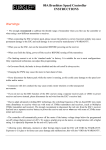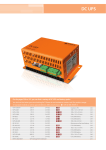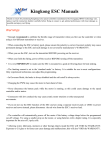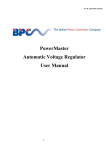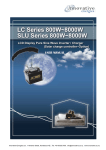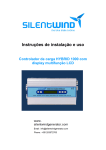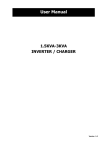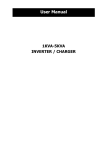Download Ceil Static UPS System Operating instructions
Transcript
Dear Customer We congratulate you for intelligently choosing CEIL Static UPS that incorporates latest DSP controlled IGBT base technology. This manual provides you a thorough understanding of your Static UPS and its optimum use. Please read the installation and operating instructions in this manual carefully before installing and using your CEIL Static UPS. Pay special attention to the section under PRECAUTIONS. Here the manual pinpoints conditions or practices which could not only result in damage to your Static UPS or other equipment but also result in personal injury or loss of life. Should you need help at any time please feel free to contact us, we would welcome any queries/suggestions from you that will enable us to improve product quality and also offer you better service. With best wishes and warm regards Management Team Exide Industries Limited India. Important Safety Instructions • • • • • • • Read this manual thoroughly before operation. Keep this instruction booklet safe. This unit is intended for installation in a temperature controlled, indoor area free from conductive contaminates. Make sure your AC input is properly grounded. Improper grounding might cause hazard and is against WARRANTY condition. While cleaning, do not apply any chemical solvent to the unit. Use dry cloth to avoid anything dripping into the circuit. Keep the unit away from damp areas. Do not leave the unit in direct sunlight. Contents Topic Page no. Knowing your CEIL DSP Sine wave Static UPS 1 Front Panel 1 Back Panel 2 Display Status 3 Some Safety Measures 4 Concept of Charging 6 Getting Started 7 Installing your Static UPS 8 Operation Installation Diagram 10 Technical Specifications 11 Troubleshooting 12 Test Report of Static UPS 13 Installation Check List 14 Knowing your Static UPS A static UPS ensures uninterrupted power supply to large electrical loads of commercial and residential establishments during power outage. In its most basic form, a Static UPS transforms Alternating Current (AC) to Direct Current (DC) for providing the required charging current for the Battery Bank connected with it and also, to convert Direct Current (DC) of the Battery Bank to Alternating Current (AC) for the electrical loads. The Battery Bank with the Static UPS acts as a reservoir to ensure continuous supply of power whenever mains supply from utility power is not available. Front Panel: Front Panel Diagram Position No. Function Remarks 1 LCD Display all parameter 2 ON/OFF ON/OFF Switch Status: Battery Voltage, Output Voltage, battery Charging and charged, Output Load in Static Inverter Mode and Mains Voltage. REAR Panel Position No. 3 4 5 6 7 8 9 10 11 12 Function Fan Inbuilt time Delay AC Mains MCB Battery MCB AC Mains Output Battery Terminal Negative (Black) Battery Terminal Positive (Red) BYPASS switch Inverter/UPS Remarks For cooling the Unit To run compressor load like A.C.Time delay relay (TDR) has been provided. To switch on the AC main (Utility Power) To switch on the DC supply For AC mains connection For output load connection To connect battery wire black To connect battery wire red In case of system failure to BYPASS the system To toggle the system in Inverter or UPS mode Display Status Status On Display Alarm IUPS I/P……………………..Volt No running on mains O/P…………………… Volt I/P Freq……………..Hz O/P Freq…………… Hz Battery Charging Battery ………………Volt Mains OK Load……………………% Battery Low Protection Battery Low Beeping Output over load Warning Beeping Overload I/P MCB Trip I/P MCB Trip Beeping O/P Short Circuit Protection Short Circuit Beeping UPS on Battery Mains not OK Beeping Every 5 Min. I/P……………………..Volt O/P…………………… Volt I/P Freq……………..Hz O/P Freq…………… Hz Load % Over Temp. Protection Over Temp. Yes SOME SAFETY MEASURES Important Precautions: CEIL DSP Sine wave Static USP has two Battery terminals coming out from the rear side, an AC MCB, a DC MCB, an AC output socket and an AC Input socket. Battery terminals are red and black in colour. The red colour terminal has to be connected to the POSITIVE TERMINAL of the battery and black one to the NEGATIVE TERMINAL. CAUTION: Do not reverse the battery connections as it will trip the Battery MCB/ Fuse. Ensure that the incoming phase (or line) is connected to 'L', Neutral is connected to 'N' and earth is connected through OUTPUT socket of the Static UPS. General Precautions: Before using the CEIL DSP Sine wave Static UPS read all instructions and caution markings on the Static UPS, the batteries and all appropriate sections of this Instruction manual. Do not expose CEIL DSP Sine wave Static UPS to any type of chemicals. Do not disassemble the CEIL DSP Sine wave Static UPS. Take it to a qualified our Engineering Service Centre when service or repair is required. Opening by unqualified person can lead to electrical shock or fire hazard. To reduce risks of electric shock disconnect all wiring before cleaning. WARNING: Avoid exposing the Static UPS or Batteries to any type of explosive gases in the vicinity as batteries generate explosive gases during normal operation. Ensure proper ventilation for the battery compartments. The Battery enclosures should be so designed as to prevent accumulation and concentration of hydrogen gas in 'pockets' at the top of the compartment. Vent the battery compartment from the highest point. A sloped lid can also be used to direct the flow to the vent opening location. To reduce the risk of battery explosion, strictly follow the instructions of the battery supplier for any equipment you intend to use in the vicinity of batteries. Use the correct tools to make AC/DC wiring connections. Do not install this CEIL DSP Sine wave Static UPS on or near flammable materials (plywood, chemicals, gasoline etc) CAUTION: The CEIL DSP Sine wave Static UPS should be connected to grounded, permanent wiring systems. Personal Precautions: A person should be within the range of your voice so as to come to your aid when you work near batteries Keep plenty of fresh water and soap nearby in the event that battery acid comes in contact with skin, clothing or eyes. Avoid touching eyes while working near batteries; Wash your hands when work done. If battery acid comes in contact with skin or clothing wash immediately with soap and water. If acid enters eyes immediately flood eyes with running cool water for at least 15 minutes and get medical attention immediately. Baking soda neutralizes battery electrolyte. NEVER smoke or allow spark or a flame in the vicinity of the battery. Be extra cautious when working with metal tools on and around batteries. It could short-circuit the batteries or other electrical parts, producing a spark that could cause an explosion. Remove personal metal items such as rings, bracelets, necklace and watches when working with the battery. Battery can produce short-circuit current high enough to cause severe burns. Never attempt to charge a frozen battery. Before touching the Battery terminal makes sure that the Static UPS front switch is OFF and AC mains to the Static UPS is also OFF. If it is necessary to remove any battery, always remove the grounded terminal from the battery first. Make sure all the accessories are off, so as not to cause arcing. Be sure that the area around the battery is well ventilated. Clean battery terminals. Be careful not to allow corrosion to come in contact with eyes. Study specific precautions and recommended rates of charge of all battery manufacturers. Add only distilled water in each cell until battery acid reaches level specified by battery manufacturer. This helps purge excessive gas from cells. Do not overfill. For a battery without caps, carefully follow manufacturer's recharging instructions. Exide India, is not responsible for any kind of battery related problems. CONCEPT OF CHARGING Five Stage Pulse Charging Bulk: Batteries are charged at maximum allowed continuous constant charging current at constant voltage for speedy charging of battery up to 13.8V (for a 12V battery). Boost: The charger checks the charging current when the battery voltage reaches 13.6V for 12V batteries. The boost mode of the charger will be activated, which will boost the battery up to 20% more than its rated voltage (14.4V for 12V batteries) and charging current is reduced to 50% of bulk charging rate (i.e. 4 to 5AMP). Taper: When the voltage level of battery is 20% more than its rated voltage, the taper mode of the charger will be activated, which will keep the charging current at about 4AMP to achieve the specific gravity of electrolyte for fully charged battery. Float: In float stage the charger keeps the charging voltage& current level at its trickle charging set point of 13.6 V with minimum charging current at 1.0 AMP. Pulse (Reset): To maintain the float level, the charger resets to zero current at 13.6V for some time and starts again with pulse charging of <1 AMP current at same voltage. This keeps the battery in full charge condition even when not in use. GETTING STARTED Environment Static UPS / Inverters are sophisticated devices and must be treated accordingly. Keep the Static UPS in a non-condensing, well-ventilated environment, ensuring there is no ingress of moisture or foreign material. Location Static UPS should be kept as close as possible to the battery in order to keep the battery cables short. However do not locate the Static UPS in the same compartment as non-sealed batteries since the gas from battery generator gases is very corrosive and can damage electronic equipment and other items. Important Precaution The output side of the Static UPS AC wiring should never be connected to a generator or incoming utility power. This condition is far worse than a short circuit. If the unit survives this condition, it will shut down until correction is made. An independent circuit breaker (MCB/MCCB) is suggested for INPUT & OUTPUT according to the CEIL Static UPS capacity. For Input, Output, battery wire thickness refers to table below. I/P WIRE THICKNESS O/P WIRE THICKNESS (sq. mm) (sq. mm) 2.5 KVA-36/48 VOLT 2.5 2.5 10 3 KVA-36/48 VOLT 2.5 2.5 16 5 KVA-48/96/120/180 VOLT 6 6 10 7.5 KVA-120/180 VOLT 10 10 16 10 KVA-180/192 VOLT 10 10 10 12 KVA-192 VOLT 16 16 16 UPS (KVA) BATTERY WIRE THICKNESS (sq. mm) INSTALLING YOUR STATIC UPS Mounting Mounting the Static UPS in a ventilated enclosure with sealed batteries is acceptable. Avoid mounting the Static UPS in a closed container. To operate at high power for sustained periods of time unrestricted airflow is required. Without the protection, circuitry will activate and reduce the maximum power available or cause complete shutdown of the Static UPS. As per standards, Static UPS should be mounted on a flat surface. NOTE: Never disconnect the battery cables while the Static UPS is delivering power or battery charger is operating. The ON/OFF switch has no effect on the charger; it only turns OFF the Static UPS. To disconnect the batteries for servicing: a) Turn OFF the power switch. b) Disconnect all AC power. c) Disconnect all the battery cables DC CABLING Ensure that the ON/OFF switch on the front panel of the Static UPS is in the OFF Position before you begin the installation; also keep DC MCB and AC MAINS MCB in OFF position. Connect the positive terminal of the battery bank to the positive (Red) terminal of the Static UPS. Connect the negative terminal of the battery bank to the negative (Black) terminal of the Static UPS. Ensure that the battery wires and interconnects are of proper rating. It is advised to use 50amp or above rated wire. AC CABLING Connect AC input supply to the input mains terminal of the Static UPS so that the phase is connected to (L), neutral is connected to (N) and earth is connected to (E). Connect output wires to the output terminals of the Static UPS so that the phase is connected to (L), neutral is connected to (N) and earth is connected to (E). Use proper rated wire for input & output AC connector. AIR CONDITIONER WIRING The air-conditioner requires a 5 minute delay each time the supply is interrupted. To provide for the time delay, a socket (TDR) is provided at the back panel of Static UPS. WARM UP Secure all the wiring with ties or other non-conductive fasteners to prevent damage. Switch on DC MCB. Check the front LCD panel. Switch on the front panel switch and verify the Static UPS operation. Switch on AC MCB and give AC mains to the Static UPS. In Static UPS of 10KVA & above, the LCD display will get ON just after connecting the battery bank with OUT switch on the battery MCB. OPERATION Once the AC and DC wiring have been installed and connected, take a moment to re-examine all the connections and make sure they are secured and in the proper terminals. Check to see that the Static UPS is turned off, and then apply battery (DC) power to it. Ensure that all wiring has been installed properly. Next turn on the battery bank DC disconnects or connects the proper fuse/MCB in line to the battery to complete the battery circuit. Put ON/OFF switch to the ON position. The Static UPS should run a load without AC mains input (battery only). Place a load on the Static UPS and make sure it works. To charge your batteries, connect AC mains to the Static UPS by plugging in the AC power and turning on the AC mains line. This shows that charger is working properly. Any AC load powered by the Static UPS should also work at this point since the AC mains passes through the Static UPS to power the loads. Disconnect the AC mains. The Static UPS should transfer to Battery mode immediately. The Static UPS will begin to take power from the batteries and use it to power the load and the load continues to operate uninterrupted. The above steps will complete a functional test of the Static UPS. If all areas pass, the Static UPS is ready for use. If areas fail, figure out why before proceeding. Installation Diagram For Static UPS Technical Specifications Trouble Shooting Static UPS Test Report Tested by …………………………………………………… Inspected by……………………………………………… Date…………………………………………………………… Date………………………………………………………….. Sign……………………………………………………………. Sign……………………………………………………………. Installation Check List Environment Place Remarks Noise Dust Without Cooling With Cooling Ventilation Distance Between UPS and Walls Y/N Y/N Y/N Y/N Y/N METER Mains Side Rating of I/P Circuit Breaker I/P Wire Thickness Back Up System Capacity (DG Set Capacity and Make) Mains Stabilizer capacity and make (if any) No. of Earthing Pit Mains Voltage Mains N-E Voltage Mains Frequency Back Up System (DG Set)Frequency AMP sq. mm. KVA 1Ph./3Ph KVA 1Ph./3Ph Hz Output Side Rating of Output Circuit Breaker O/P Wire Thickness Output Voltage Output N-E Voltage Output Frequency Output Load AMP sq. mm. Volts Volts Hz Battery Distance Between Battery Pack and UPS Battery Wire Thickness Battery Capacity/Make/Type/MFD Date Tightness Of Battery Wire in UPS side and Battery side Battery Inter connectors wire thickness and tightness METER sq. mm. Earthing Earth for Chasis Earth for Neutral Customer’s Sign ………………………………………… Engineer’s Sign…………………………………………. Name………………………………………………………… Name……………………………………………………….. Date………………………………………………………….. Date…………………………………………………………. Customer Awareness Static UPS /Inverter Technology use : DSP Sinewave Capacity of Inverter : ……………..VA No. of Battery use/DC voltage : ………..Nos / ……………Volt DC Input Voltage range : (120V-280V) in normal mode (180V-260V) in UPS mode Output voltage : 230 Volt AC Output current at full load : ……………….AMP Output frequency : 50HZ+/- 1.0% (stable) Output wave form : Sinewave Static UPS front panel : ON/Off switch and LCD display Rear panel : Mains MCB, Battery MCB, Bypass & switch, I/P Terminal Block & O/P Terminal Block Battery Connections Battery Care : Please check the water level in the battery once in two months. Make sure Battery terminal should be clean. Customer’s Sign ………………………………………… Engineer’s Sign…………………………………………. Name………………………………………………………… Name………………………………………………………..




















